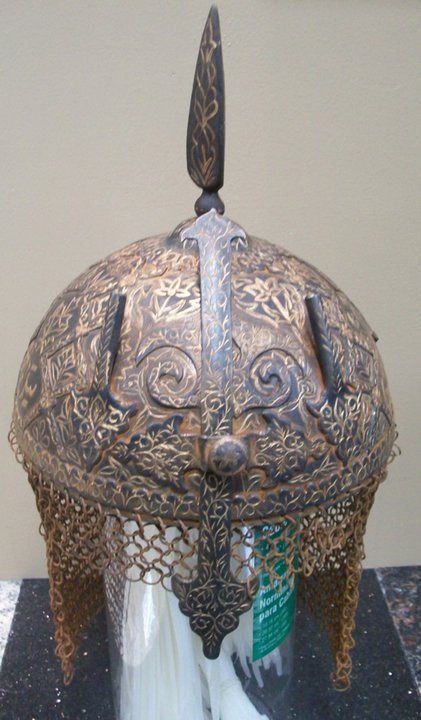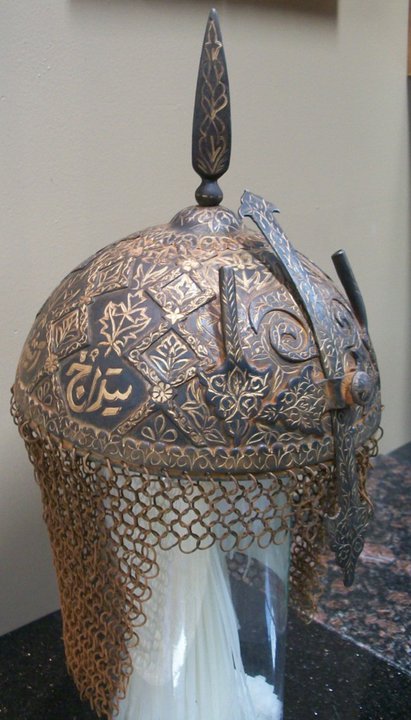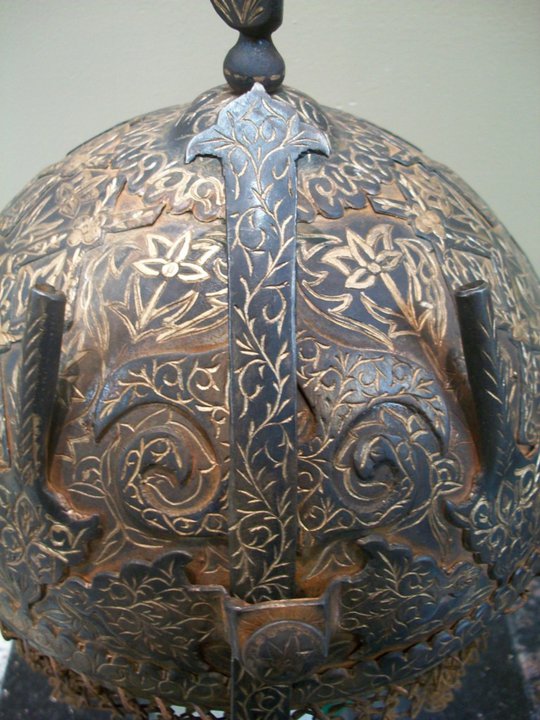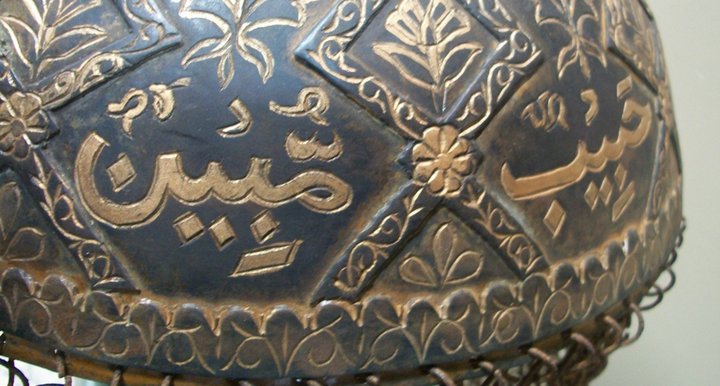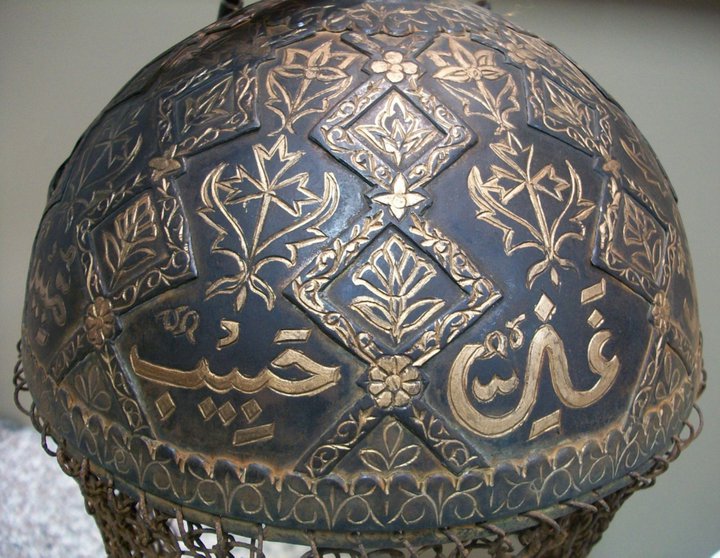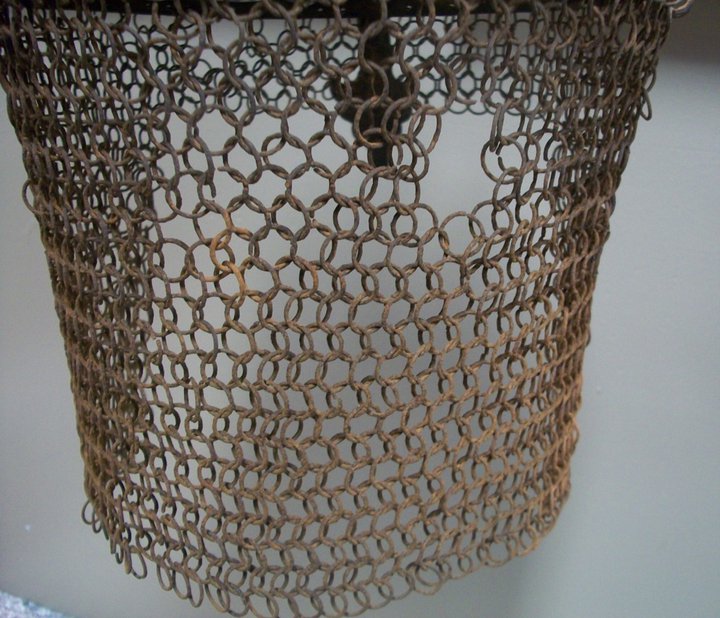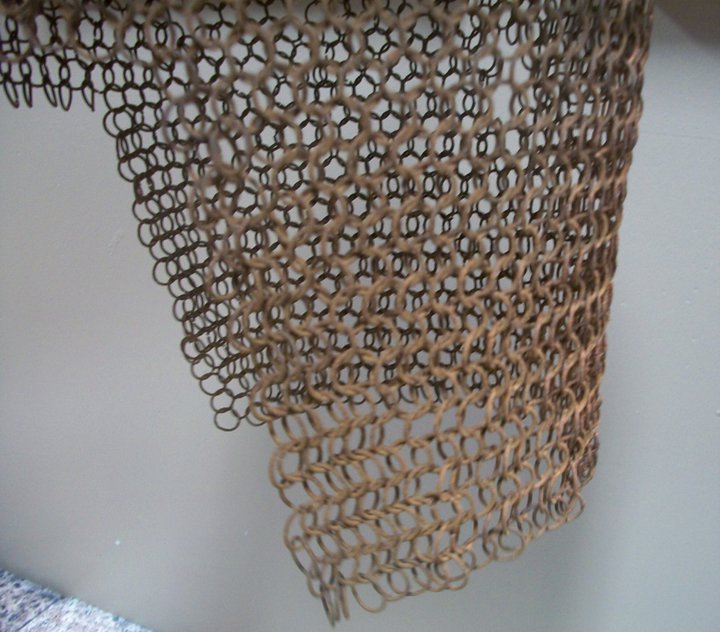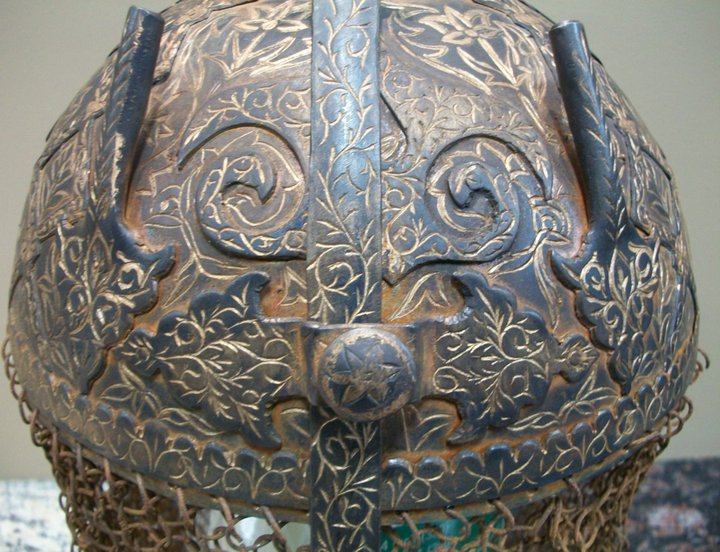Posts: 3 Location: Canada
Wed 08 Feb, 2012 12:39 pm
Indo Persian Helmet? Identification of Head Piece
Posts: 138
Wed 08 Feb, 2012 8:54 pm
Im not an expert and i could be wrong but itís at the youngest itís an early Saracen helm from maybe the first or second crusade. The thing that makes me think that is the nasal guard, Iíve only seen them on early helms from the middle east. but they had extensive trade routes throughout the middle east and into china so it could have been used or made in any of the countries that are now Israel, Iran, Iraq, Saudi Arabia, or Jordan
Posts: 483 Location: Somerset UK
Wed 08 Feb, 2012 10:46 pm
Based on examples I've seen in the Wallace and Royal Armouries, early modern (ie 17th-19th century) century Persian.
Posts: 669 Location: Dinuba, CA
Thu 09 Feb, 2012 2:08 am
*Most Likely* a Quajar Dynasty era helmet (c. 1785-1925), probably from the early-mid 19th century. Here are some other examples of the style.
http://www.peterpetrou.com/persian-helmet-and-shield/
http://www.flickr.com/photos/kitonlove/4662201926/
http://www.oriental-arms.com/item.php?id=2257
http://www.goantiques.com/scripts/images,id,2331524.html
Cheers.
-Gregory
(EDIT: I hate using absolutes. This is not "definitely" anything!)
Last edited by Gregory J. Liebau on Thu 09 Feb, 2012 2:08 pm; edited 1 time in total
Posts: 3 Location: Canada
Thu 09 Feb, 2012 3:03 am
Thank you all for the replies. Any chance this could be a Mughal era helmet? I have seen Mughal helmets and they also have the plume holders. Also, if it is Qajar, would they not have used Farsi instead of Arabic when engraving? And would that be real Gold engravings?
Any opinions on the condition?
Also anyone know what the words in Arabic means?
Posts: 1,563 Location: Upstate NY
Thu 09 Feb, 2012 4:49 am
| Quote: |
| Any chance this could be a Mughal era helmet? I have seen Mughal helmets and they also have the plume holders. |
The top spike and plume holders are common throughout the Indo-Persian region and do not therefore act as an indicator persae of area/time period of origin. Gregory is however probably correct, the butted maille ventail lends itself to a 19th/early 20th century date. If possilbe I would see about getting the Arabic translated, may help nail down region of origin as the simple existance of Arabic rather Farsi engraving on this khula khud, does not alone indicate Arab/Persian origins. I guess the only real flag for me on this ( based on pictures alone ) is the excellent condition of the gold on this helmet, while not unique, it is uncommon and given the large amounts of " new " work comming out of the region these days I would seek as much authentication as possible.
Posts: 239 Location: California
Thu 09 Feb, 2012 6:53 am
Indo Persian Helmet?
Am inclined to chime in with Allan. By all means seek authentication. There is a lot of "new" stuff on the market, some of it pretty authentic looking and some not so great.
I am not an expert, but do have two helmets of this type for comparison. A couple of things drew my attention, one being that the gold looks like paint vs. wire hammered into chasing (a common though not the only method used). And the rust has a red tint, with any age the oxidation is very dark...usually black.
Please keep us posted on your research..
Regards,
Dan
Posts: 450 Location: Montreal,Canada
Thu 09 Feb, 2012 7:04 am
gold?
Hi,
a local jeweller should be able to tell you if you have any gold leaf, as opposed to paint, on that helm. At first glance, with the photos, I tend to agree with Daniel that it looks more like paint. Also the mail seems modern, much too big in circumference to be of any use to a nineteenth century warrior. The three first pics posted by Gregory show a tighter weave, the fourth is less so, but still smaller than the one you are investigating. I also think that authentication is the way to go.
Posts: 1,563 Location: Upstate NY
Thu 09 Feb, 2012 8:57 am
| Quote: |
| Also the mail seems modern, much too big in circumference to be of any use to a nineteenth century warrior. |
Jean not at all for the 19th century. Ring sizes varied considerably, from tiny 3/16 inch ID rings to close to 1/2 inch ID rings ( this difference extends to riveted maille for the region as well. When I used to collect Indo-Persian heavilly I owned a maille khula zira that was made up of 3/16 inch ID riveted rings , a maille and plates coat of riveted maille of the same diameter, two that were closed to 5/16 inch ID riveted maille and one that was a little over 3/8 inch ID riveited in general ) Given the prevelance of simple butted maille in this region in the 19th and early 20th centuries, as well as what was being made for the tourist/export market ring diameter at that time ring diameter is not a large indicator of age in this region.
Posts: 450 Location: Montreal,Canada
Thu 09 Feb, 2012 9:14 am
mail size
Thanks Allan, I will defer to your experience in this matter. I have seen things like this in different ''antique'' stores in
Montreal, more and more of these pieces pop up as our immigration attracts more incoming permanent residents from
India, Iran, Afghanistan and Pakistan. The mail, though rusted, looks roughly like the stuff I used to do for my SCA costumes, so I have ever been wary about provenance as the dealers don't seem to know themselves. Thanks for the input.
Posts: 1,563 Location: Upstate NY
Thu 09 Feb, 2012 10:48 am
| Quote: |
| The mail, though rusted, looks roughly like the stuff I used to do for my SCA costumes, so I have ever been wary about provenance |
Jean something to note is that this type of helmet, the khula khud was made very late ( i've seen one made from a GI pot helmet ) for use in what were sometimes termed " romance plays " in the region, performed during festivals and such depicting stories of famous heroes. The really late ones have a non descript engraving, usually a hunting scene, and most often a camail of galvinized, butted steel rings and rather than a sliding nasal ( one that can slid up and down by means of a set screw or a small lever that locks it in an up or down position ) a fixed nasal that is simply held in place by a rivet and would be mannually turned through and arch into a down or up position. This http://www.google.com/imgres?imgurl=http://ww...amp;itbs=1 is typical of these late khula khud ( auction price is not meant as an assement of value, it is simply the only image I could find handilly ).
Posts: 3 Location: Canada
Thu 09 Feb, 2012 11:11 am
I will go to a local jeweler and see if they can identify that as having gold work. Will post updates.
The circumference where they head goes in between the
chain mail is actually very small, so whoever wore it, must have had a very small head. Nevertheless, it is a great piece of art, even if it is not an antique. It looks fabulous on display, especially if you add two ostrich plume feathers onto it!
Posts: 27 Location: Nottingham / Sheffield, UK
Sat 11 Feb, 2012 7:38 am
I think it is more Indian than Persian - Persian helmets had very deep, hemi-spherical bowls, whereas Indian ones were flatter. Although, it is a little hard to tell on this piece, it seem somewhere in between the two extremes!
The screw for the nasal also looks odd to me. The screws are usually flattened vertically so you can grip it (does this make sense?), whereas this is more of a knob.
The decoration looks a fair bit coarser than any earlier helmets, I would think it was rather made for a foreign collector rather than for an actual Indian / Persian who wanted to wear it to fight, quite late (late 19th C?). The style of decoration is also a little unlike ones I've seen, and several of the "vowel marks" on the writing are placed in an odd way, and the way the letters are formed looks a little odd too. Of course, it could simply have been made by a less literate armourer ...?
Although, I may be suffering from sampling bias :p
Posts: 8 Location: Orlando Florida
Thu 15 Nov, 2012 12:52 pm
| Nadeem Ahmad wrote: |
I think it is more Indian than Persian - Persian helmets had very deep, hemi-spherical bowls, whereas Indian ones were flatter. Although, it is a little hard to tell on this piece, it seem somewhere in between the two extremes!
The screw for the nasal also looks odd to me. The screws are usually flattened vertically so you can grip it (does this make sense?), whereas this is more of a knob.
The decoration looks a fair bit coarser than any earlier helmets, I would think it was rather made for a foreign collector rather than for an actual Indian / Persian who wanted to wear it to fight, quite late (late 19th C?). The style of decoration is also a little unlike ones I've seen, and several of the "vowel marks" on the writing are placed in an odd way, and the way the letters are formed looks a little odd too. Of course, it could simply have been made by a less literate armourer ...?
Although, I may be suffering from sampling bias :p |
To me this looks most likely to be an Islamic Indian helmet, 19th century from Hyderabad.
According to "Arms and Armour - Traditional Weapons of India" by E. Jaiwant Paul, the helmet is surmounted by a plume holder. The nasal guard is also flanked by plume holders. The entire dome and fittings are profusely decorated in creeper and geometrical designs in zar-buland. A camail of chain mail is attached for the protection of the neck.
The arabic script is islamic.
 Attachment: 148.72 KB
Attachment: 148.72 KB
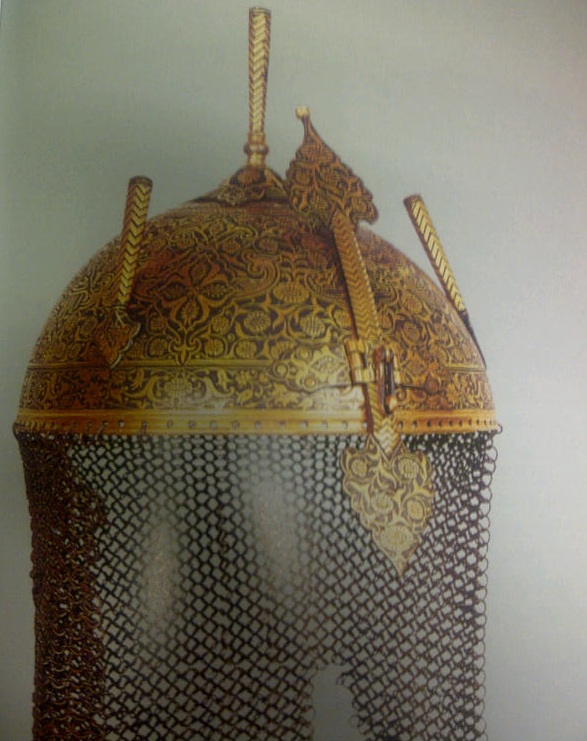
Posts: 416 Location: Auckland, New Zealand
Thu 15 Nov, 2012 1:18 pm
That's a beautiful helmet.
Very nice find and score, mate!
You
cannot post new topics in this forum
You
cannot reply to topics in this forum
You
cannot edit your posts in this forum
You
cannot delete your posts in this forum
You
cannot vote in polls in this forum
You
cannot attach files in this forum
You
can download files in this forum
